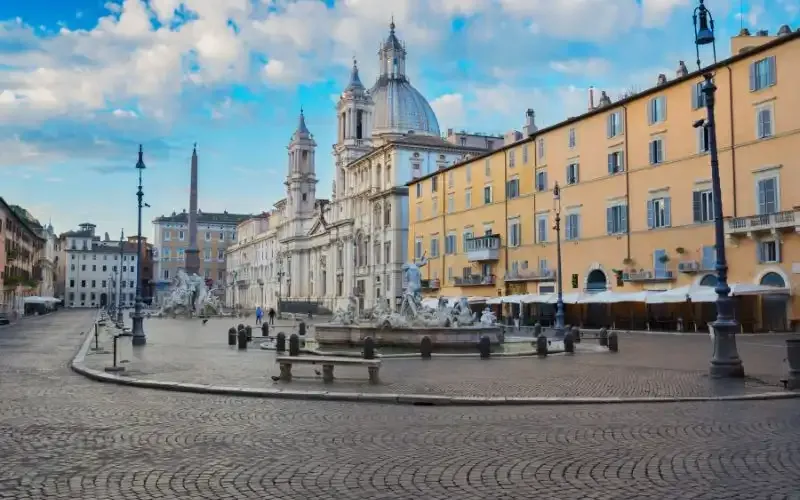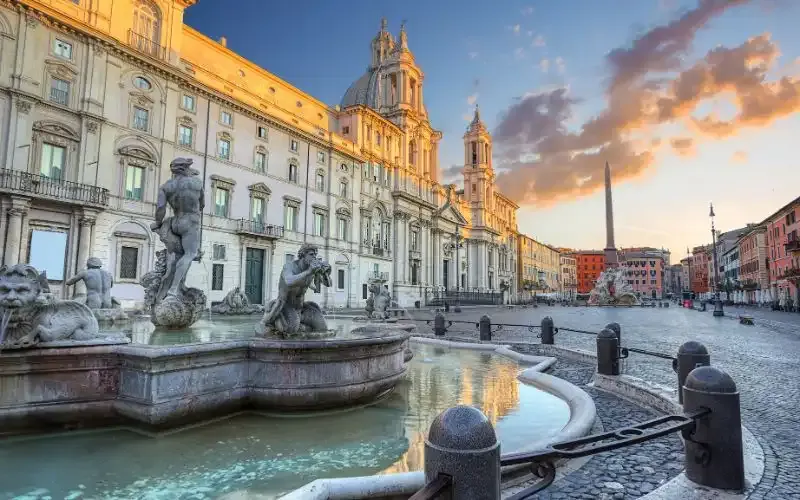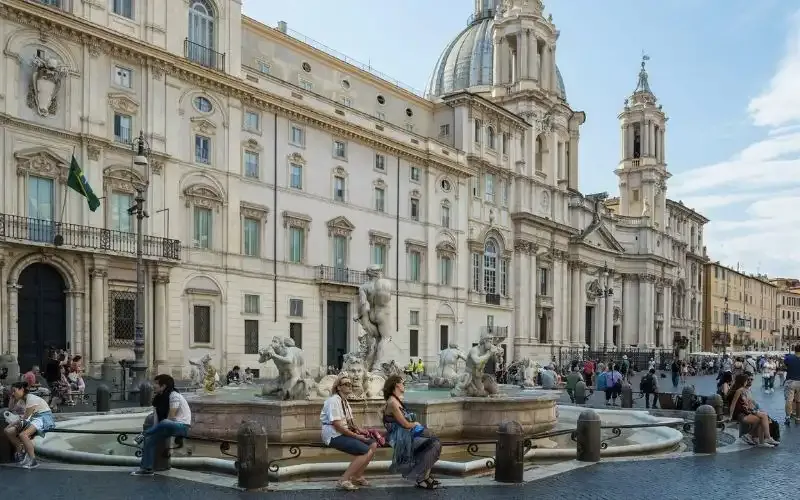Piazza Navona, the vibrant heart of Rome, is not only a famous tourist destination but also a living symbol of Italian culture, history, and art. With its magnificent space, splendid Baroque architecture, and lively atmosphere, Piazza Navona is where visitors can immerse themselves in the Roman rhythm of life, appreciate timeless beauty, and capture unforgettable moments. Spending time to check-in at Piazza Navona offers you not just stunning photos but also the opportunity to explore one of humanity’s most precious cultural heritages.
The History of Piazza Navona: Imprints of Time

To truly appreciate the beauty of Piazza Navona, we need to journey back in time and explore the rich history that shaped this unique space. Piazza Navona was not built from scratch; it was formed on the foundations of a grand ancient Roman structure – the Stadium of Domitian.
In the 1st century AD, Emperor Domitian commissioned a vast stadium, capable of holding approximately 30,000 spectators, to host sporting and entertainment events. This stadium had an elongated shape, similar to the current shape of the square. Over time, the Stadium of Domitian was gradually forgotten and fell into ruin. However, its shape was preserved, defining the space of Piazza Navona today.
By the 15th century, Piazza Navona began to revive and transform into a public space. This area became a center of activity for the church and papal families, with commercial activities and markets held regularly. Under the patronage of Pope Innocent X in the 17th century, Piazza Navona was reshaped with magnificent Baroque architecture, turning it into a vital cultural and social hub of Rome.
From 1652 to 1866, Piazza Navona was also the venue for street festivals and unique water games. In the summer, the square was transformed into an artificial “lake” by blocking the drains of the three fountains, creating a recreational and cooling space for the people of Rome. Today, although these events are no longer held, Piazza Navona remains a vibrant square, attracting tourists and locals alike to visit, enjoy, and soak in the special atmosphere of Rome.
Baroque Architecture Masterpieces at Piazza Navona

Piazza Navona is considered one of the most typical and perfect examples of Baroque architecture in Rome. Stepping into the square, you will be immediately overwhelmed by the splendor, extravagance, and artistry of the surrounding architectural works.
At the heart of Piazza Navona is the church of Sant’Agnese in Agone, a Baroque masterpiece built in the 17th century. The church’s façade, with its soft curves, majestic columns, and imposing dome, creates a beauty that is both solemn and enchanting. Inside the church, visitors can admire magnificent frescoes, exquisite sculptures, and an elaborately decorated interior, showcasing the pinnacle of Baroque art.
The most prominent highlights of Piazza Navona are the three beautiful fountains, each with its own style and meaning. The Fontana dei Quattro Fiumi (Fountain of Four Rivers) in the center of the square is a famous work by the genius sculptor Gian Lorenzo Bernini. This fountain symbolizes the four major rivers of the world known at the time: the Nile (Africa), the Danube (Europe), the Ganges (Asia), and the Rio de la Plata (Americas). The vivid, powerful statues depicting river gods and mythical creatures create an impressive work of art full of symbolic meaning.
To the north of the square is the Fontana del Nettuno (Fountain of Neptune), built in the 16th century. This fountain depicts the sea god Neptune fighting an octopus, surrounded by mythological figures and sea creatures. The Fontana del Moro (Moor Fountain) is located to the south of the square, featuring a statue of a Moor (African man) wrestling with a dolphin. All three fountains are unique sculptural works, contributing to the magnificent and lively beauty of Piazza Navona.
In addition to religious buildings and fountains, Piazza Navona is also surrounded by ancient buildings and magnificent palaces, imbued with Baroque architectural style. These buildings not only have historical and cultural value but also create a harmonious and unified architectural space, captivating anyone who sets foot in the square.
Unique Experiences at Piazza Navona: Beyond Check-ins

Piazza Navona is not just a place to sightsee and take photos, but also a place to experience and immerse yourself in the vibrant life of Rome. There are many interesting activities you can explore when visiting this square:
Stroll and feel the square’s atmosphere: Piazza Navona is a large pedestrian square, ideal for leisurely walks, admiring the architecture, appreciating the artworks, and feeling the bustling rhythm of Rome. In the morning, the square has a peaceful and tranquil beauty, perfect for sipping an espresso and enjoying the fresh air. As night falls, Piazza Navona becomes shimmering and magical with golden lights, and street artists begin to perform, creating a lively and bustling atmosphere.
Enjoy Italian cuisine and cafes: Around Piazza Navona, there are many cafes, restaurants, and eateries with diverse styles and price ranges. You can choose an outdoor cafe, order a cappuccino or a refreshing gelato, and watch people passing by. If you want to enjoy Italian cuisine, you can find traditional restaurants and try specialties such as pizza, pasta, risotto, and tiramisu.
Explore street art and local culture: Piazza Navona is a vibrant street art stage. You can easily encounter portrait painters, musical performers, artisans making handicrafts, and many other unique art forms. Take time to observe, interact, and enjoy these artistic performances to learn more about Roman culture and people.
Shopping and souvenirs: Around Piazza Navona, there are many shops selling souvenirs, handicrafts, fashion clothing, and typical Italian products. You can find unique gifts to give to loved ones, friends, or simply to keep as a memento of your trip to Rome.
Visit nearby landmarks: Piazza Navona is centrally located in Rome, very close to many other famous attractions such as the Pantheon, Castel Sant’Angelo, and Campo de’ Fiori square. You can combine visiting Piazza Navona with these places for a complete and exciting exploration of Rome.
Check-in at Piazza Navona: “Million Likes” Photo Spot Suggestions

With its unique architectural beauty and magnificent space, Piazza Navona is a paradise for photography enthusiasts. To get “million likes” check-in photos at this square, you can refer to some of the following suggestions:
- Fontana dei Quattro Fiumi: The central fountain is the most prominent highlight of Piazza Navona. You can take panoramic photos of the fountain from various angles, or close-up shots of the statues and intricate sculptural details. The best time to photograph the fountain is in the early morning or late afternoon when the natural light is soft and not too harsh.
- Sant’Agnese in Agone Church: The church’s façade with its dome and Baroque details is a great background for portraits or group photos. You can take photos from the front of the church, or go inside and take photos with the magnificent interior space.
- Neptune and Moor Fountains: The two smaller fountains are also interesting check-in spots. You can take close-up photos of the statues and decorative details of these two fountains, or take panoramic photos of the square with all three fountains creating a harmonious composition.
- View from above: If you want a panoramic view of Piazza Navona, find cafes or restaurants with terraces or balconies overlooking the square. From above, you can capture overarching photos of the entire square space, especially in the evening when the square is brilliantly lit.
- Candid photos: Besides majestic architectural photos, you can also capture everyday moments at Piazza Navona, such as images of locals and tourists strolling, chatting, enjoying coffee, or street artists performing. These photos will help you preserve authentic and vivid memories of Piazza Navona.
Conclusion: Piazza Navona – A Must-Visit Destination in Rome
Piazza Navona is not just a square, but a symbol, a story, an unmissable experience when visiting Rome. From its unique history, magnificent Baroque architecture to its vibrant atmosphere and diverse cultural experiences, Piazza Navona leaves visitors with deep and unforgettable impressions. Take the time to check-in at Piazza Navona, explore its timeless beauty, and feel the heartbeat of the Eternal City. Surely, Piazza Navona will be a special highlight in your journey to discover Italy.